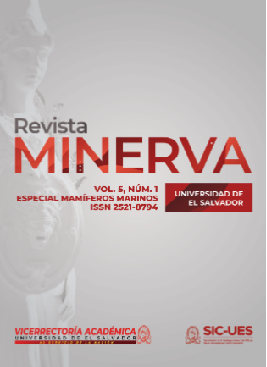El avistamiento de Ballenas, una herramienta para la educación y conservación de entornos marinos en El Salvador a través de la actividad turística
Palabras clave:
Cetáceos, Ecoturismo, Conservación de áreas protegidasResumen
En poco menos de un siglo, el turismo se ha convertido en uno de los principales motores de la economía global, se estima que en 1950 hubo 25 millones de viajeros internacionales, para 2019 ese número se había disparado hasta alcanzar 1.4 billones. Esa masificación de la industria ha llevado a muchos académicos a estudiar sus impactos negativos, sin embargo, también se han dedicado muchos esfuerzos para hacer del turismo una herramienta de cambio que pueda llevar desarrollo económico a las comunidades. Cada vez más el patrimonio natural y cultural son vistos como las bases de una oferta turística diferenciada, es así como el ecoturismo en la actualidad es una de las formas de turismo responsable preferidas y una de las más diversas. Dentro de los ambientes marinos el avistamiento de ballenas se ha convertido, en poco tiempo, en uno de los segmentos de mayor éxito y crecimiento. Por ello, en este papel examinamos brevemente el potencial de esta actividad como un importante instrumento de conservación y educación, no solo alrededor de los cetáceos, sino de los ecosistemas marinos en general. De igual forma, abordamos su potencial como generador de oportunidades de crecimiento económico para las comunidades costeras de El Salvador.
Descargas
Referencias
Castaneda, M. G., Flores, A. H., & Salgado, J. D. (2017). Caracterización de la actividad turística de avistamiento de cetáceos en la comunidad Los Cóbanos, Acajutla, Sonsonate entre noviembre de 2014 y abril de 2015. Universidad de El Salvador.
Cortés, J. (1997). Biology and geology of eastern Pacific coral reefs. Coral Reefs, 16(5), S39–S46. https://doi.org/10.1007/ s003380050240
Gallardo, R. (2016). Patrimonio cultural marítimo de El Salvador: Registro de pecios. UNESCO. 10.1007/s11457-017-9179-6
Hoyt, E. (2001). Whale watching: Worldwide tourism numbers, expenditures, and expanding socioeconomic benefits. International Fund for Animal Welfare.
Hoyt, E., & Folkens, P. (1984). The whale watcher’s handbook. Penguin Books Canada.
Hoyt, E., & Iñiguez, M. (2008). The State of Whale Watching in Latin America. WDCS, Chippenham, UK; IFAW.
Hoyt, E., & Parsons, E. C. M. (2014). The whalewatching industry. En J. Higham, L. Bejder, & R. Williams (Eds.), Whalewatching (pp. 57–70). Cambridge University Press. https://doi.org/10.1017/ CBO9781139018166.006
Ingle, R. (1991). Thomas Cook of Leicester (J. Loades, Ed.). Headstart History.
Komar, O. (2009). Comprehensive Inventories of Selected Biological Resources within Targeted Watersheds and Ecological Corridors of Southwestern El Salvador. USAID El Salvador, Improved Management and Conservation of Critical Watersheds Project
Lee, S.-M., & Robineau, D. (2004). Les cétacés des gravures rupestres néolithiques de Bangu-dae (Corée du Sud) et les débuts de la chasse à la baleine dans le Pacifique nord-ouest. L’Anthropologie, 108(1), 137–151. https://doi.org/10.1016/j. anthro.2004.01.001
Luksenburg, J., & Parsons, E. (2009). The effects of aircraft on cetaceans: Implications for aerial whalewatching. Proceedings of the 61st Meeting of the International Whaling Commission.
Markham, C. (1882). On the whale fisheries of the Basque provinces of Spain. Proc. Zool. Soc. London.
MARN. (2019). Manual de avistamiento responsable de cetáceos en El Salvador. Ministerio de Medio Ambiente y Recursos Naturales.
McCollough, J., & Check, H. F. (2010). The Baleen Whales’ Saving Grace: The Introduction of Petroleum Based Products in the Market and Its Impact on the Whaling Industry. Sustainability, 2(10), 3142–3157. https://doi.org/10.3390/su2103142
Ministerio de Medio Ambiente y Recursos Naturales (MARN). (2017). Manual para el avistamiento responsable de cetáceos en El Salvador. https://cidoc. marn.gob.sv/documentos/manualpara- el-avistamiento-responsable-decetaceos- en-el-salvador/
Minton, G., Collins, T., Pomilla, C., Findlay, K., & Rosenbaum, H. C. (2008). Megaptera novaengliae (Arabian Sea subpopulation). IUCN Red List of threatened species: IUCN.
Rijkelijkhuizen, M. (2009). Whales, Walruses, and Elephants: Artisans in Ivory, Baleen, and Other Skeletal Materials in Seventeenth- and Eighteenth-Century Amsterdam. International Journal of Historical Archaeology, 13(4), 409. https:// doi.org/10.1007/s10761-009-0091-0
Rodiño, L., & Masson, F. (2015, octubre 29). Diseño e implementación de una barrera acústica para motores fuera de borda en embarcaciones náuticas de recreo. XIII Congreso Argentino de Acústica, VII Jornadas de Acústica, Electroacústica y Áreas Vinculadas, Buenos Aires 29 y 30 de Octubre de 2015.
Siebert, L., Kimberly, P., & Pullinger, C. R. (2004). The voluminous Acajutla debris avalanche from Santa Ana volcano, western El Salvador, and comparison with other Central American edificefailure events. En W. I. Rose, J. J. Bommer, D. L. López, M. J. Carr, & J. J. Major, Natural Hazards in El Salvador. Geological Society of America. https:// doi.org/10.1130/0-8137-2375-2.5
Urzainqui, T., & Olaizola Iguiñiz, J. M. de. (1998). La Navarra marítima. Pamiela.
Descargas
Publicado
Número
Sección
Licencia

Esta obra está bajo una licencia internacional Creative Commons Atribución-CompartirIgual 4.0.


